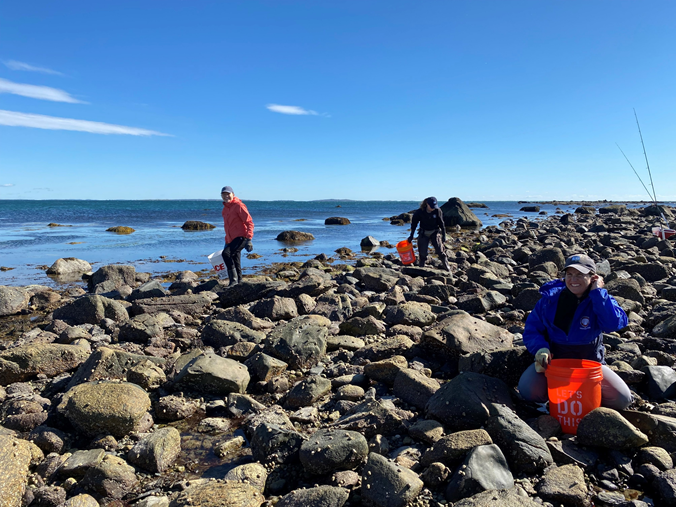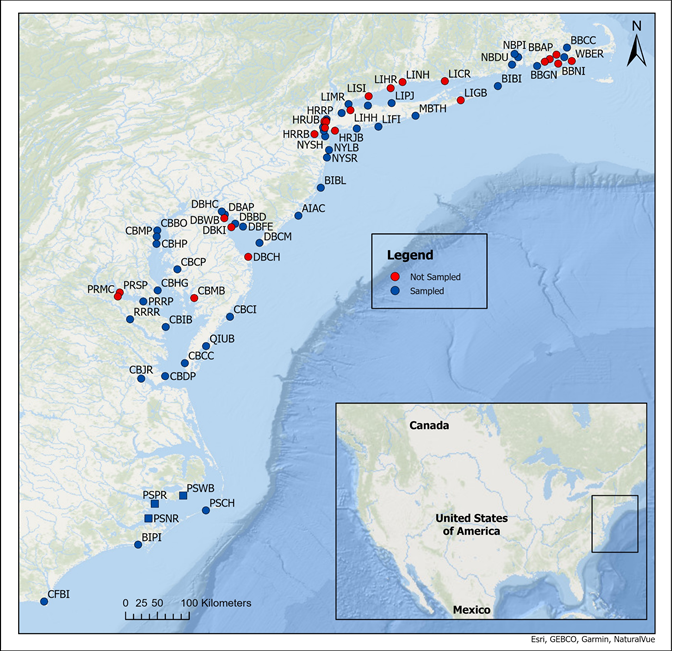
The Mussel Watch Program has monitored the nation’s coastal waters for chemical contaminants since 1986 and in recent decades has expanded its monitoring to include trace metals, legacy contaminants, and contaminants of emerging concern (CECs). In 2021, the program collected oyster (Crassostrea virginica), mussel (Mytilus edulis), and sediment samples from a network of 46 sites in the Mid-Atlantic region. Results from this study will support a better understanding of the sources, fate, and transport of contaminants in the region and will fill important data gaps for local stakeholders.
Why We Care
Chesapeake Bay is the largest estuarine system in the continental United States, with a watershed that covers over 64,000 square miles over parts of six states and provides critical habitats for wildlife and important fisheries (NOAA, 2021). However, centuries of land development and agricultural and industrial activities have degraded water quality in the bay and its tributaries as a result of toxic chemical pollution, extensive sedimentation, and hypoxic (low oxygen) conditions (Hartwell and Hameedi, 2007; Newell, 1988; US EPA et al., 2012). To the north, commercial fisheries, including aquaculture, as well as tourism and hospitality businesses are principal income-generating enterprises and are associated with coastal population growth in the region. The high productivity of these ecosystems along with their high potential for contamination make these coastlines important to monitor.
Thousands of chemical contaminants from many land-based point and nonpoint sources accumulate in the Mid-Atlantic region every day, compromising water quality and, consequently, threatening human and ecosystem health. Previous studies in the region have investigated legacy contaminants, such as trace elements and persistent organic pollutants (e.g., polychlorinated biphenyls (PCBs), organochlorine pesticides, chlordane, and polycyclic aromatic hydrocarbons (PAHs)). These research and monitoring efforts have helped managers limit the impact that legacy contaminants have on coastal ecosystems, but such efforts are lacking for the increasing number of new and unregulated compounds known as contaminants of emerging concern (CECs), many of which are known to be harmful to people, animals, and the environment. In response to resource managers’ concerns about the extent and impact of these chemical stressors, the Mussel Watch Program conducted a basin-wide survey in 2021 to assess the magnitude and distribution of a suite of CECs, metals, and legacy contaminants in the Mid-Atlantic region.
What We Are Doing
The Mussel Watch Program uses an ecosystem-based approach to monitoring, which entails measuring the concentration of chemical contaminants in sediments and the tissues of indigenous bivalves, such as oysters and mussels, as a way to evaluate local environmental quality. Bivalves are used as indicator organisms for chemical pollution because they tend to bioaccumulate contaminants from the large amounts of water they filter, they have limited mobility, and they are found throughout the U.S. coastal zone.
The program currently analyzes sediment and bivalves for both legacy contaminants and CECs. Legacy contaminants, monitored by Mussel Watch since 1986, include compounds such as chlordanes, chlorobenzenes, dichlorodiphenyltrichloroethane (DDT), dieldrins, endosulfans, hexachlorocyclohexanes (HCHs), butyltins, PAHs, and PCBs. The monitoring of CECs began in 2009 and includes contaminants such as alkylphenols, alternative flame retardants, current-use pesticides, (per- and polyfluoroalkyl substances (PFASs), polybrominated diphenyl ether (PBDEs), polybrominated biphenyls (PBBs), and pharmaceuticals and personal care products. In general, CECs are minimally regulated, not commonly monitored, but potentially toxic chemicals that are finding their way into the environment.
In 2021, Mussel Watch analyzed sediment, oyster (Crassostrea virginica), and mussel (Mytilus edulis) samples from a network of 70 sites in the Mid-Atlantic for metals, legacy contaminants, and CECs. In this survey, 19 samples of Mytilus edulis, 24 of Crassostrea virginica, and 3 of sediment were collected across the coastlines of Massachusetts, New York, New Jersey, Rhode Island, Maryland, Virginia, and North Carolina following standard Mussel Watch Program protocols. Sites were selected based on recent success of historic site locations and the availability of collaborator support in the region. Although 70 sites from the region were identified to be sampled, only 43 sites yielded enough mussels or oysters for laboratory analyses due to site accessibility and oyster abundance at historic locations (3 sites were analyzed for sediment only).
The national Mussel Watch Program designed the 2021 Mid-Atlantic region chemical stressors survey in collaboration with the Buzzards Bay Coalition, the Hudson River Foundation, the New York State Department of Environmental Conservation, the University of Rhode Island, the New Jersey Department of Environmental Protection, the Maryland Department of the Environment, the Virginia Marine Resources Commission, the Virginia Institute of Marine Science, and the University of North Carolina Wilmington.
Benefits of Our Work
This study supplies much-needed data to the national Mussel Watch Program and local stakeholders and managers in the Mid-Atlantic region and informs water quality data used by coastal resource managers to develop effective, long-term policies to protect ecosystem services provided by the Mid-Atlantic region.

